AzureWave Technologies NU182H IEEE 802.11b/g/n 2x2 USB Half-Mini-Card Wireless Module User Manual
AzureWave Technologies, Inc. IEEE 802.11b/g/n 2x2 USB Half-Mini-Card Wireless Module
User Manual
AW-NU182H
IEEE 802.11b/g/n 2x2
USB Half-Mini-Card Wireless Module
User’s Manual

I. Introduction
i. Overview
AzureWave Technologies, Inc. introduces the pioneer of the IEEE 802.11b/g/n 2x2 USB
Half-Mini-Card wireless module ---AW-NU182H. The AW-NU182H USB Half-Mini-Card wireless
module is a highly integrated wireless local area network (WLAN) solution to let users enjoy the
digital content through the latest wireless technology without using the extra cables and cords. It
enables a high performance, cost effective, low power, compact solution that easily fits onto one
side of a USB Half-Mini-Card.
Compliant with the IEEE 802.11b/g/n standard, the AW- NU182H uses Direct Sequence Spread
Spectrum (DSSS), Orthogonal Frequency Division Multiplexing (OFDM), BPSK, QPSK, CCK and
QAM baseband modulation technologies.
A high level of integration and full implementation of the power management functions specified in
the IEEE 802.11 standard minimize system power requirements by using AW- NU182H.
Longer Range and Faster Speed
Comparing to 802.11g technology, 802.11n standard make big improvement on speed and range. It
Increases wireless range by up to 2 times and reduces dead spots in coverage area. The data rate
can up to 300Mbps data rate.
ii. Features
USB Half-Mini-Card.
Compliant with IEEE802.11n standard
2 antennas to support 2(Transmit) 2(Receive) technology
High speed wireless connection up to 300Mbps
Low power consumption and high performance
Enhanced wireless security
iii. Product Review
When the USB wireless module is transmitting data through connection, LED indicator will blink.
1. Connection Mode
◎Infrastructure Mode
Infrastructure mode needs an access point to establish the network, which can provide wireless
accesses within valid range for users to communicate with others or transmit data with a wired
network. There are several benefits of Infrastructure networking:
√ Roaming: a wireless LAN enabled computer can physically move from the operating range of one
access point to the other without losing connection. There is a quick association made between new
access point and wireless device as the computer traverses from the coverage of one access point to
another.
√ Range Extension: each wireless LAN enabled computer within the range of access point can
communicate with other wireless LAN enabled computers within the effective range from the access
point.
√ Wired to wireless LAN connection: the access point will establish a bridge between wireless LAN
and other wired counterparts.
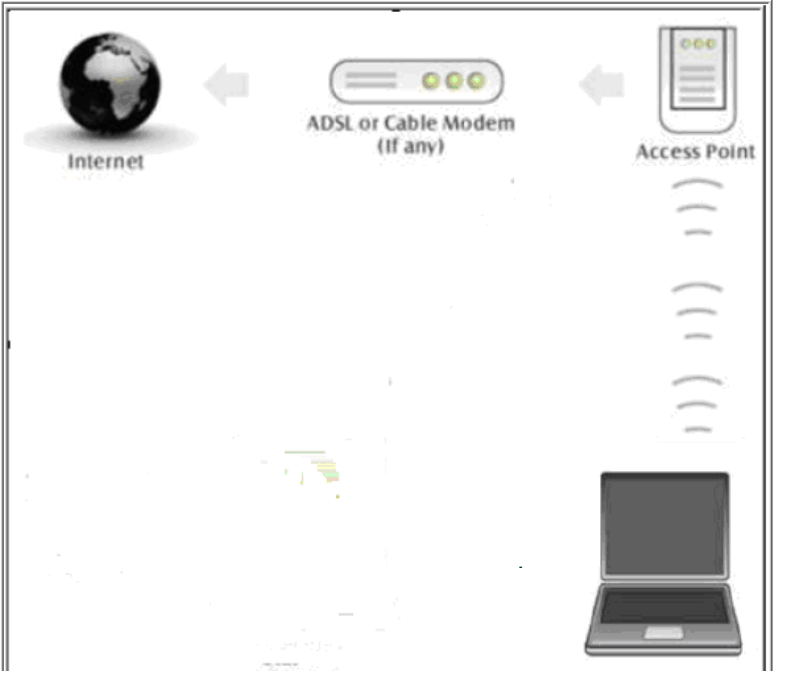
Infrastructure Mode
◎Ad-hoc Mode
The difference between Ad-hoc mode and Infrastructure mode is that Ad-hoc mode does not need
the access point or router. When you use this mode, your computer will act as a server within the
valid range and connect directly to others in the same LAN workgroup.
AW-NU182H
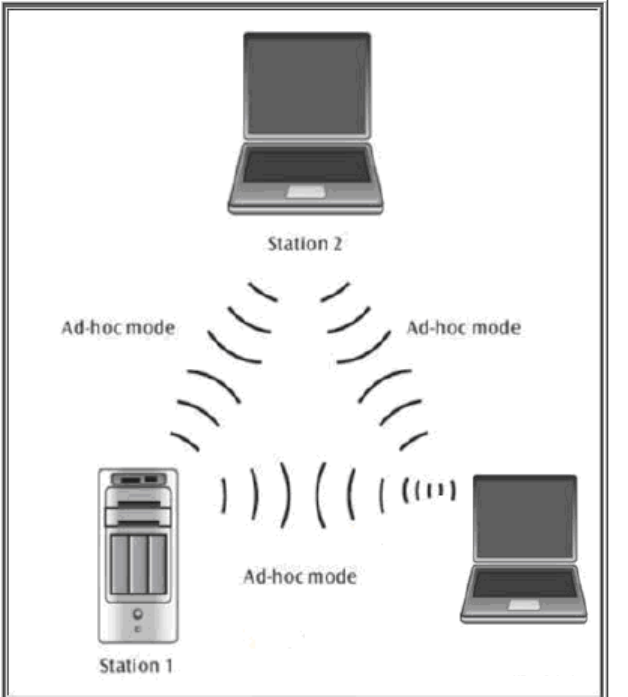
Ad-hoc Mode
It is recommended to choose this mode when there is no access point showed on your wireless
network.
AW-NU182
H
II. Installation
i. System Requirements
Before you install AW-NU182H, please make sure your system meets the following requirements.
*Laptop with mini PCI-E slot (slot support USB D+ D-)
*Minimum of 64MB system memory
*Operating system: XP/Vista/Win7
*An optical drive/CD-ROM for utilities and driver installation
ii. Hardware Installation
1. Find an available mini PCI-E port (slot support USB D+ D-) on your laptop.
2. Install AW-NU182H Wireless USB Module into laptop PCI-E slot.
iii. Operation Range
The operating range of AW-NU182H varies from the working environment. However, this device
made improvement on speed and range, which also reduced dead spots in coverage area.
AW-NU182H is two times wider than previous wireless products.
By default, this USB wireless half size mini card will automatically adjust the data rate. The
transmission speed may vary according to the environment. The closer the wireless stations are the
better the signal and transmission speed they will receive.
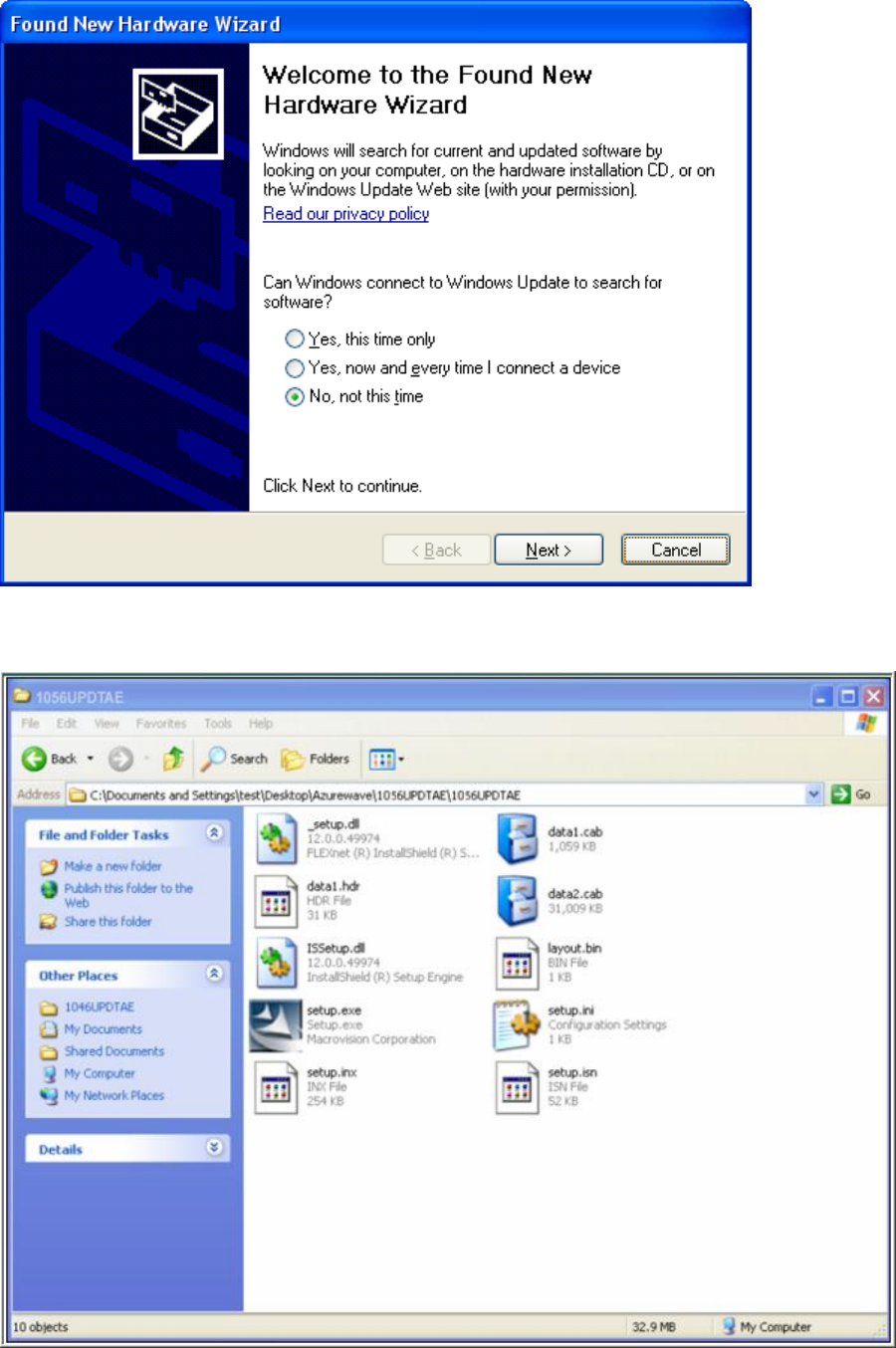
iv. Setup: Windows XP OS
If your computer is running a Windows operating system, it will automatically detect the
AW-NU182H after the system boots up and displays a “Found New Hardware Wizard” window.
Please click [Cancel] and proceed with the following steps.
1. Find out the Driver, and launch the Setup Wizard
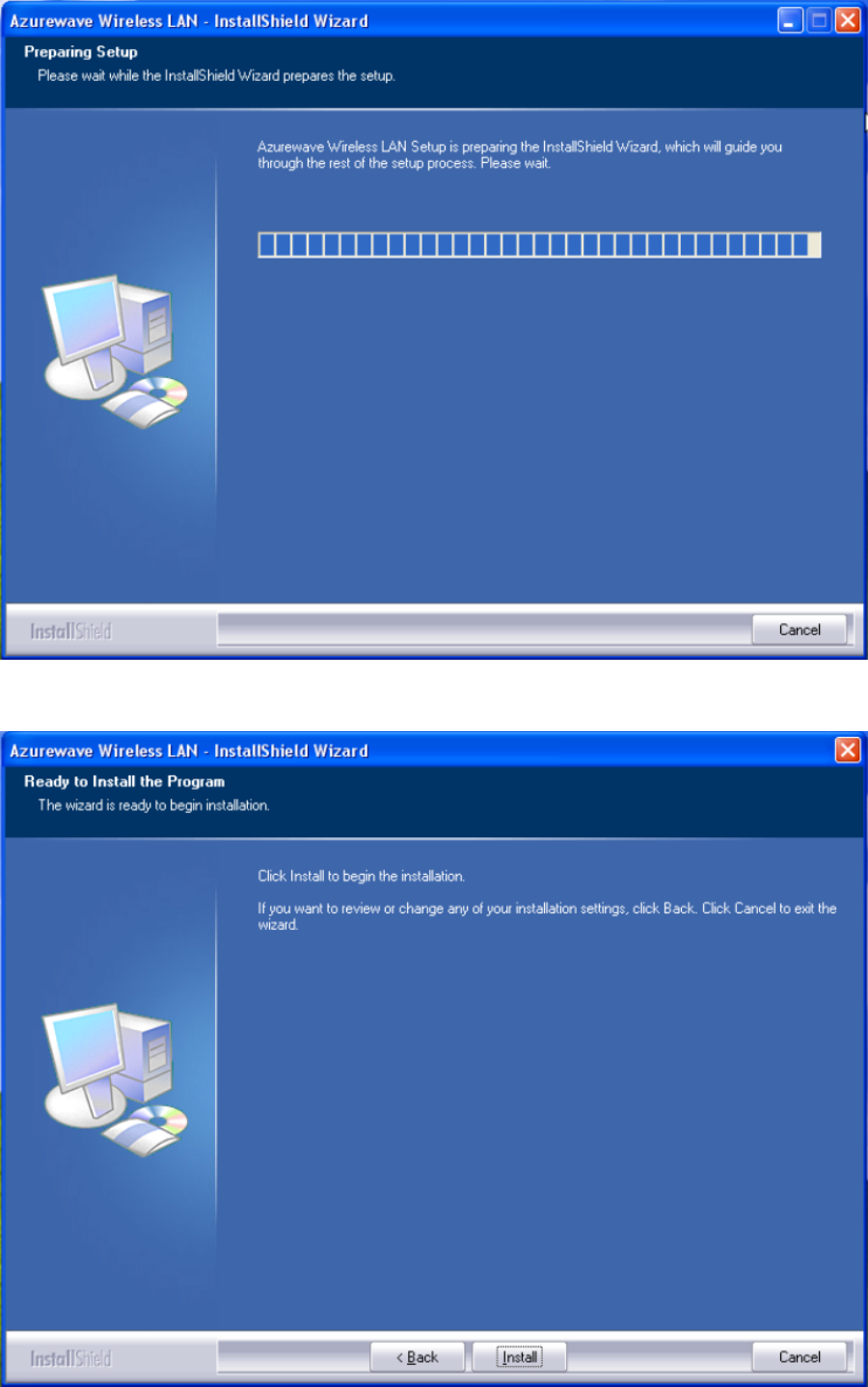
2. Please wait few seconds for wizard to prepare installation
3. Please select click [Install] to proceed
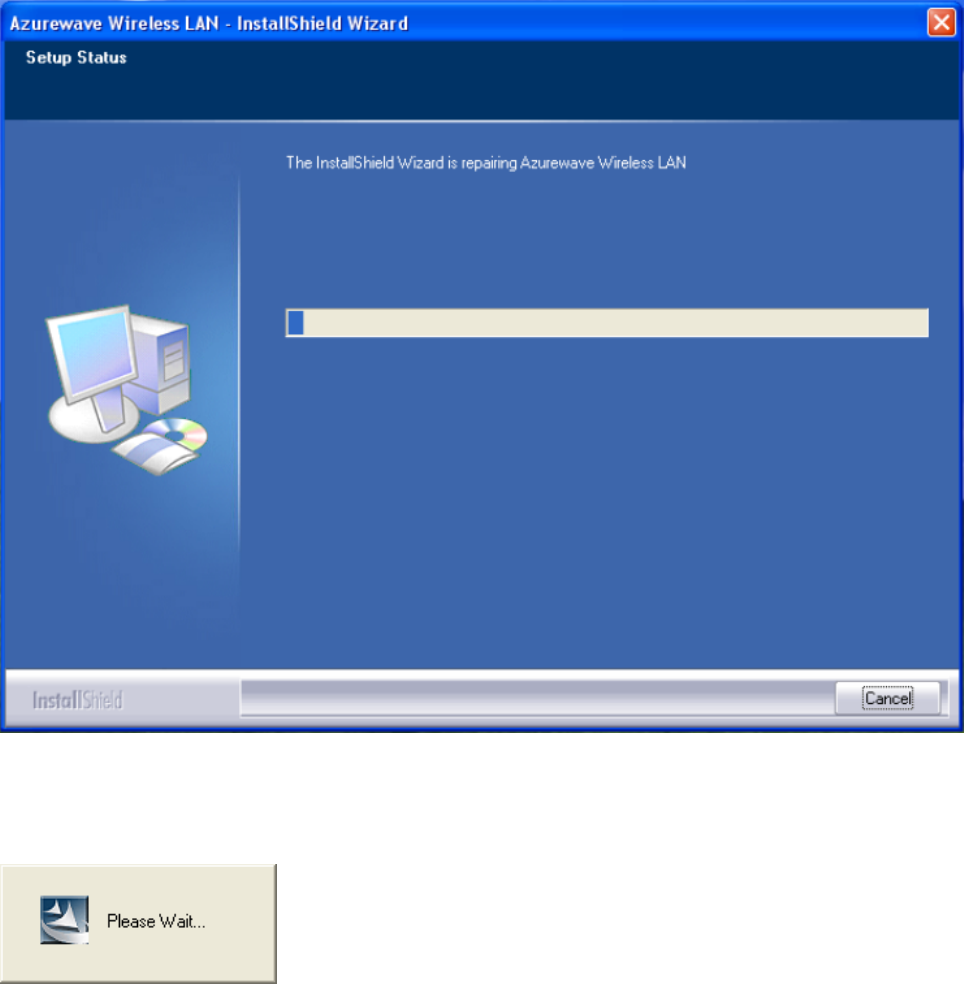
4. The Wizard is running installation
5. Please wait few seconds for Wizard to setup
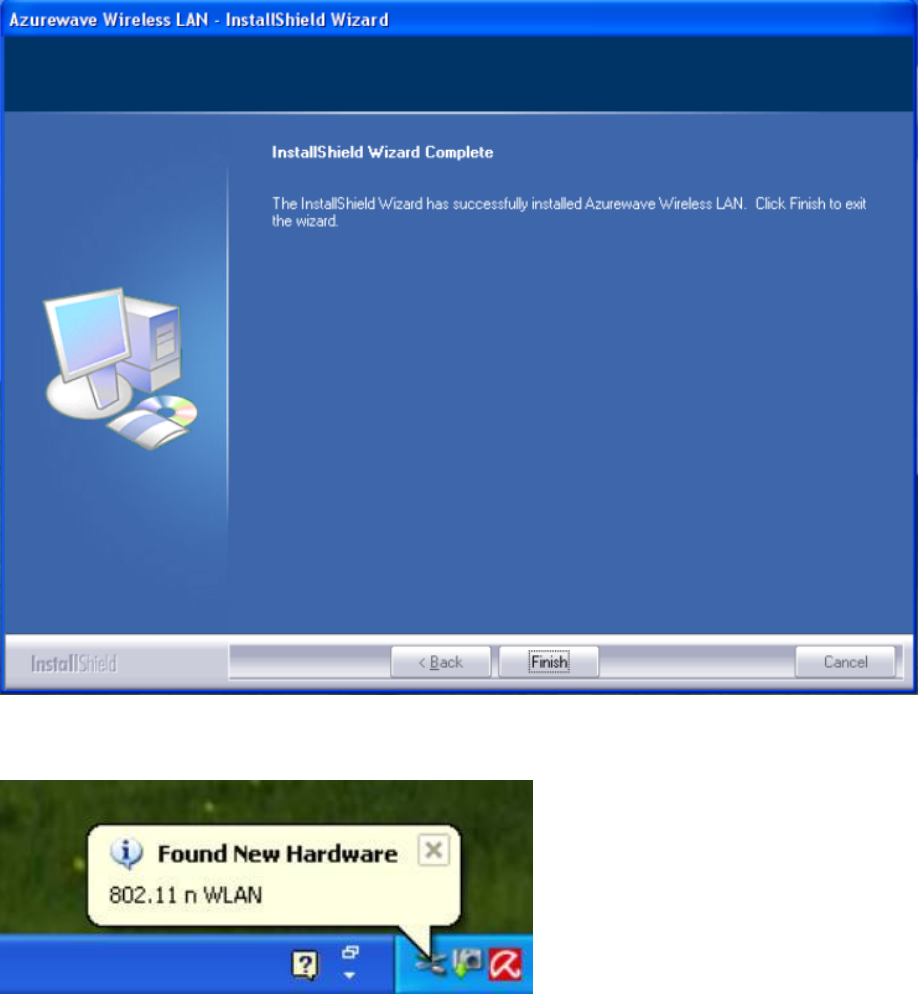
6. When it is completed, please click [Finish]
9. When the process is finished, the system will show a message of “Found New Hardware”
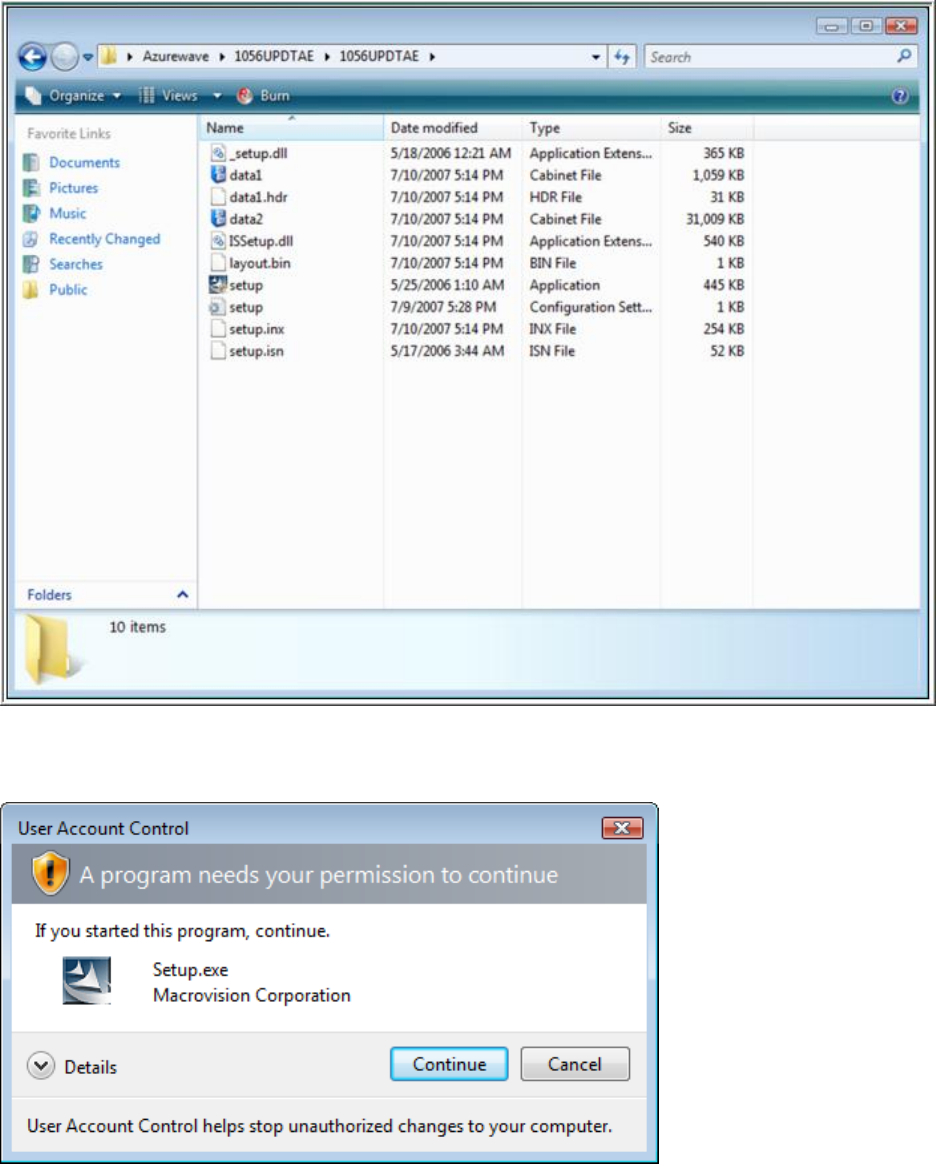
v. Setup: Windows Vista OS
Please follow the steps to complete installation.
1. Launch the setup driver
2. When you see the permission dialogue box, please click [Continue]
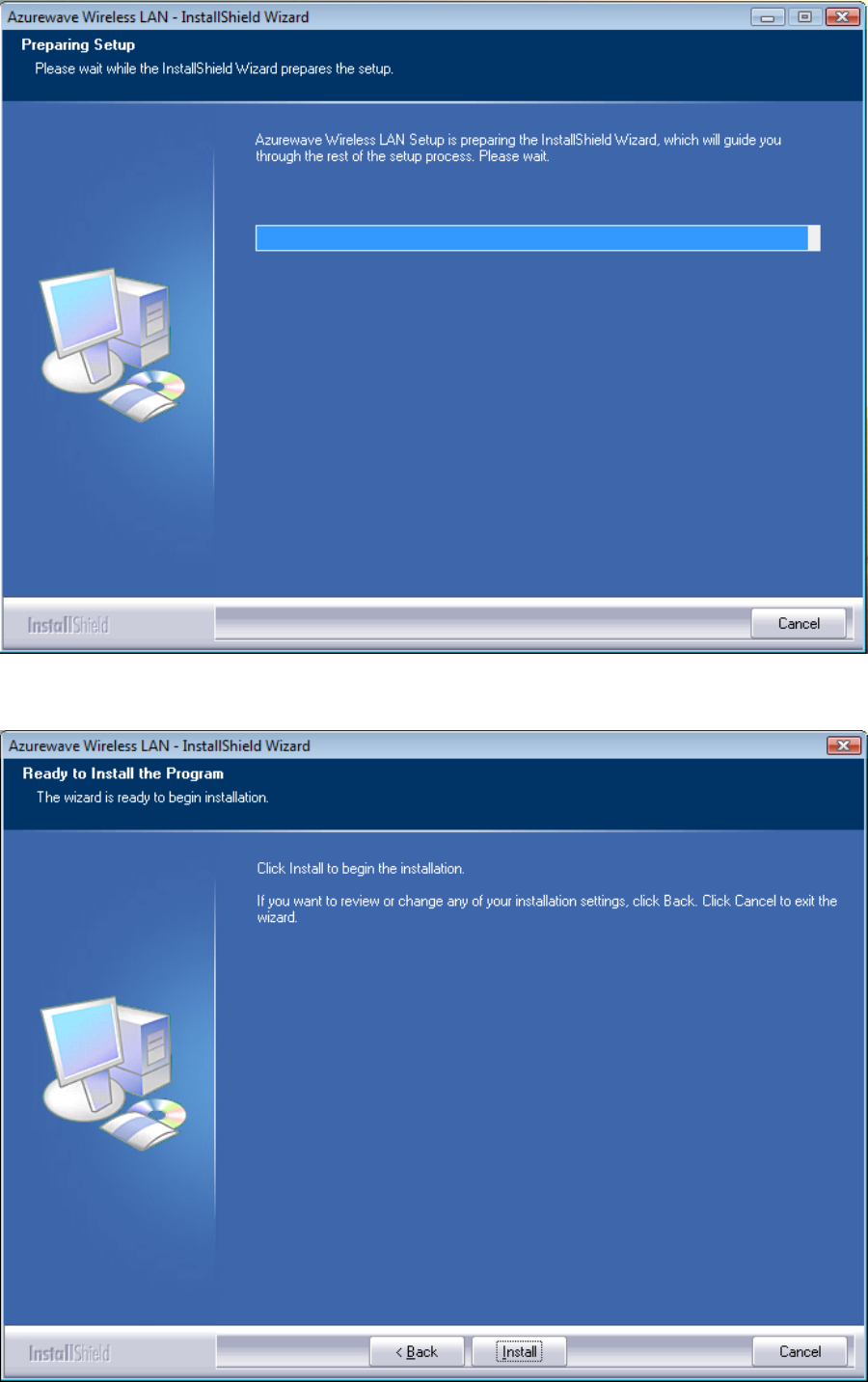
3. Now the Wizard is preparing installation
4. Please click [Install] to proceed
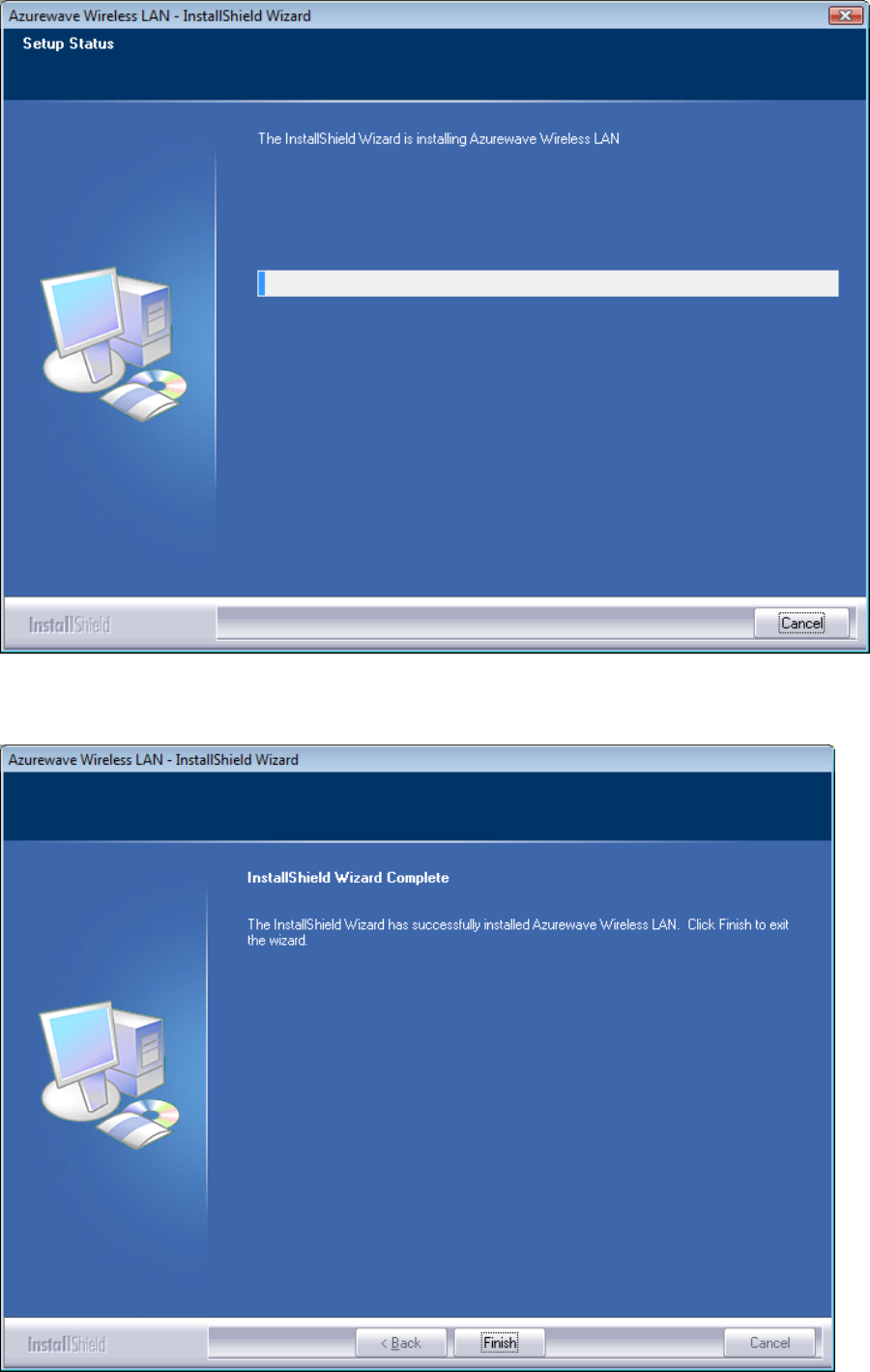
5. The system is process installation
8. When the setup is completed, please click [Finish]
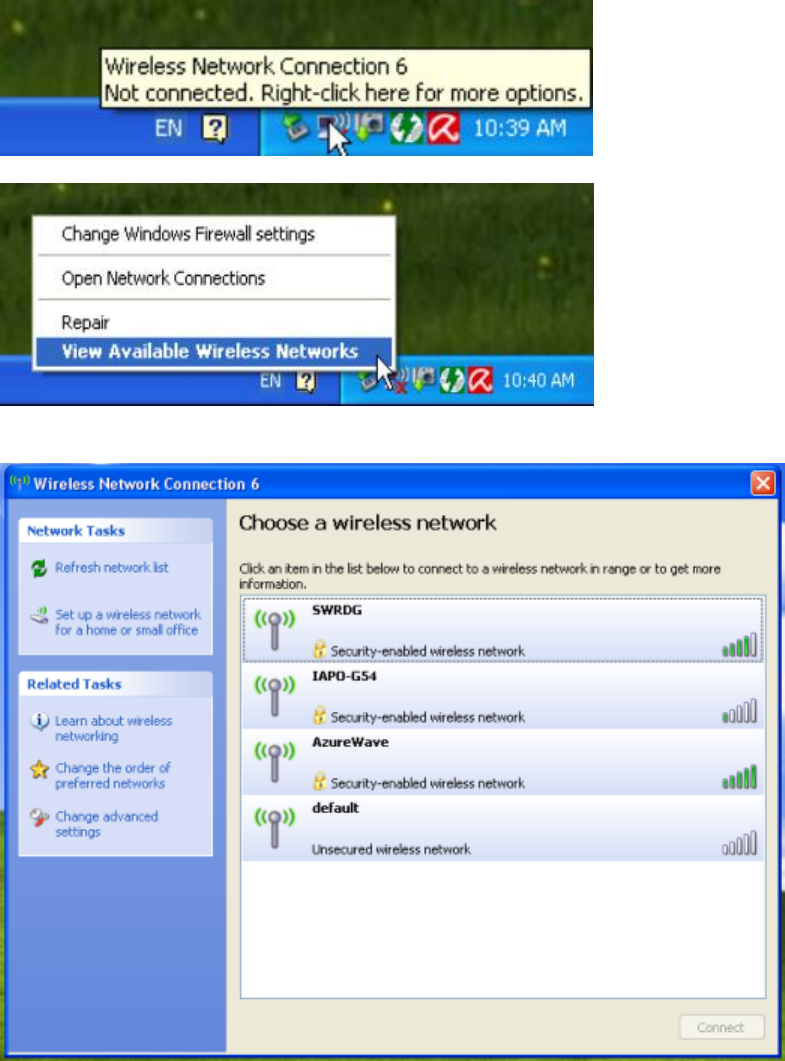
III. Network Connection
i. For Windows XP OS
Please see the following steps to setup network connection for Windows XP.
1. Find the network icon on the desktop shortcut and right-click on it. Choose “View Available
Wireless networks”
2. You will see several options, please select one and click [Connect]
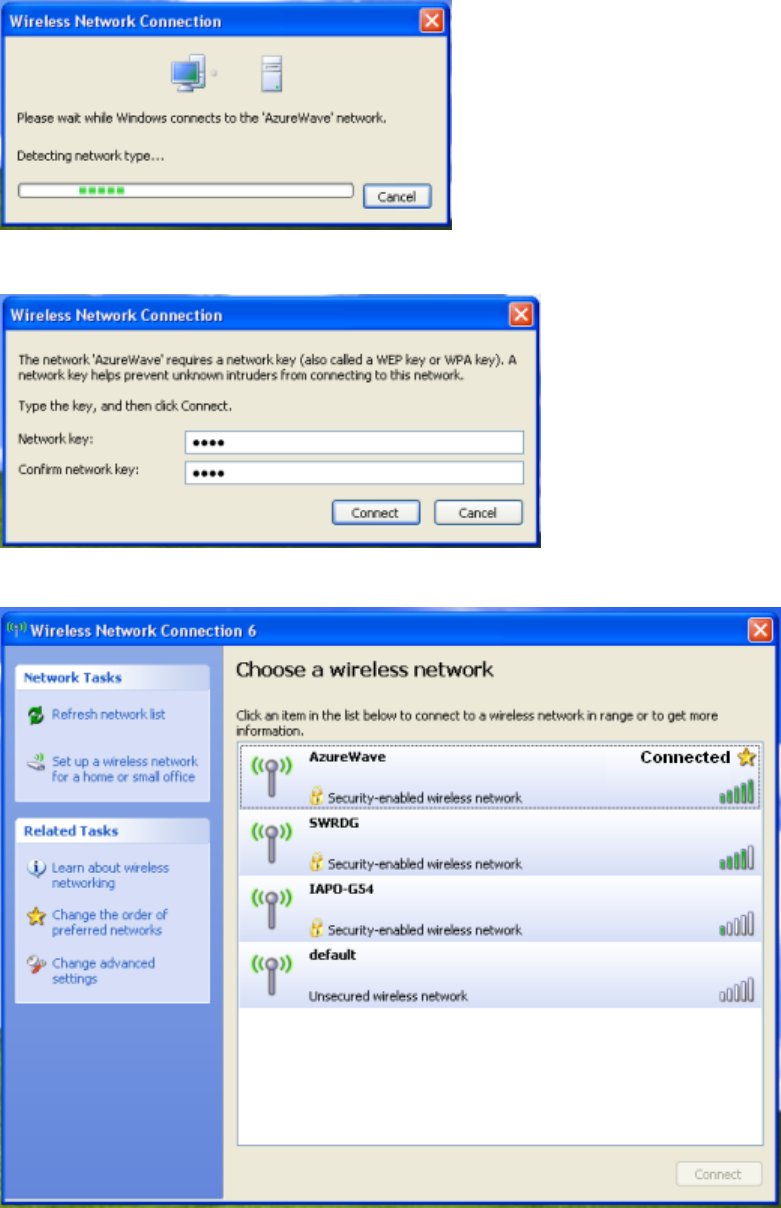
3. Please wait for few seconds to let system connecting to selected wireless network
4. You may need to type the network key when it is required
5. Now the selected wireless network is connected
6. You can check the connection status by clicking [Status] in the pop-up dialogue
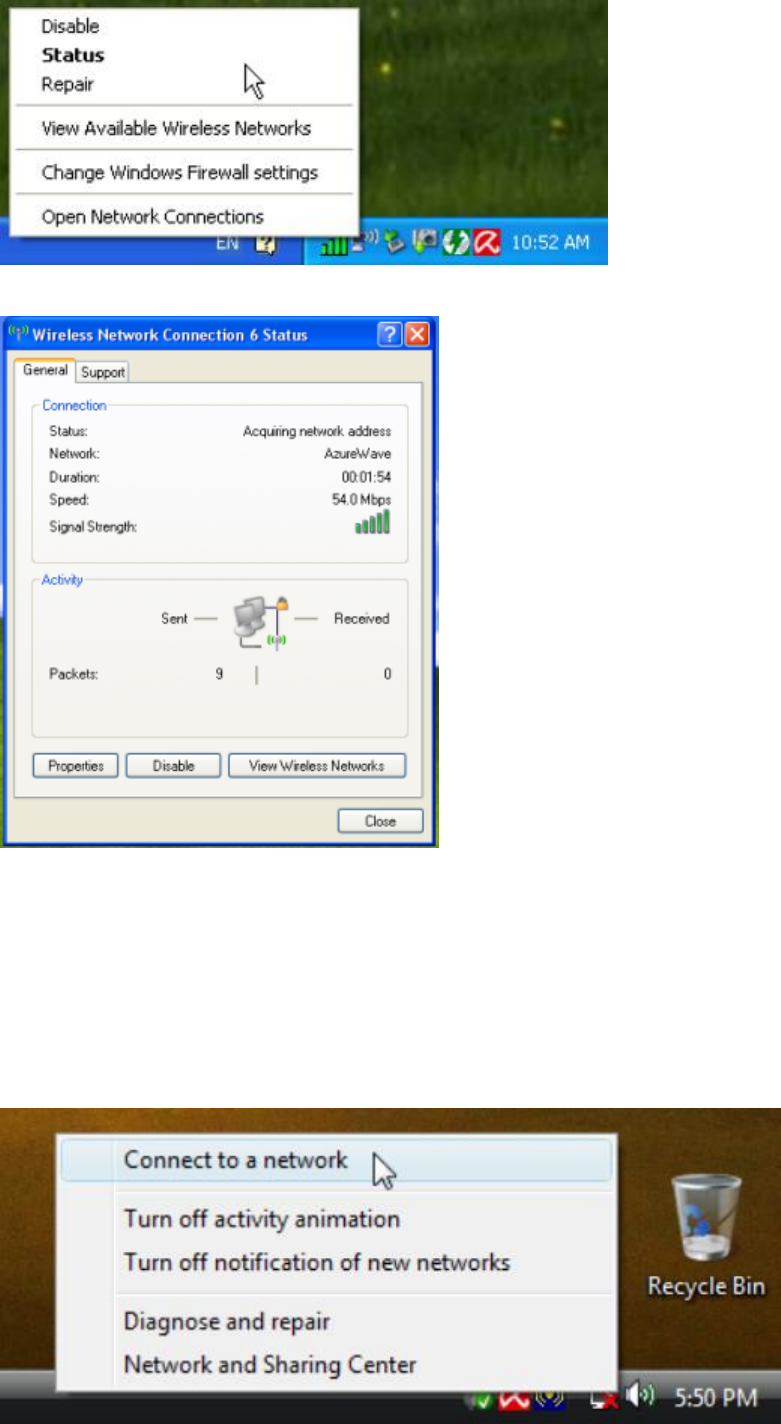
7. Here is the wireless network connection status
ii. For Windows Vista OS
Following are the instructions to setup wireless connection for Windows Vista.
1. Right-click on the network icon located on desktop shortcut. When you see the dialogue, please
click [Connect to a network]
2. Choose wireless network within your range and click [Connect]
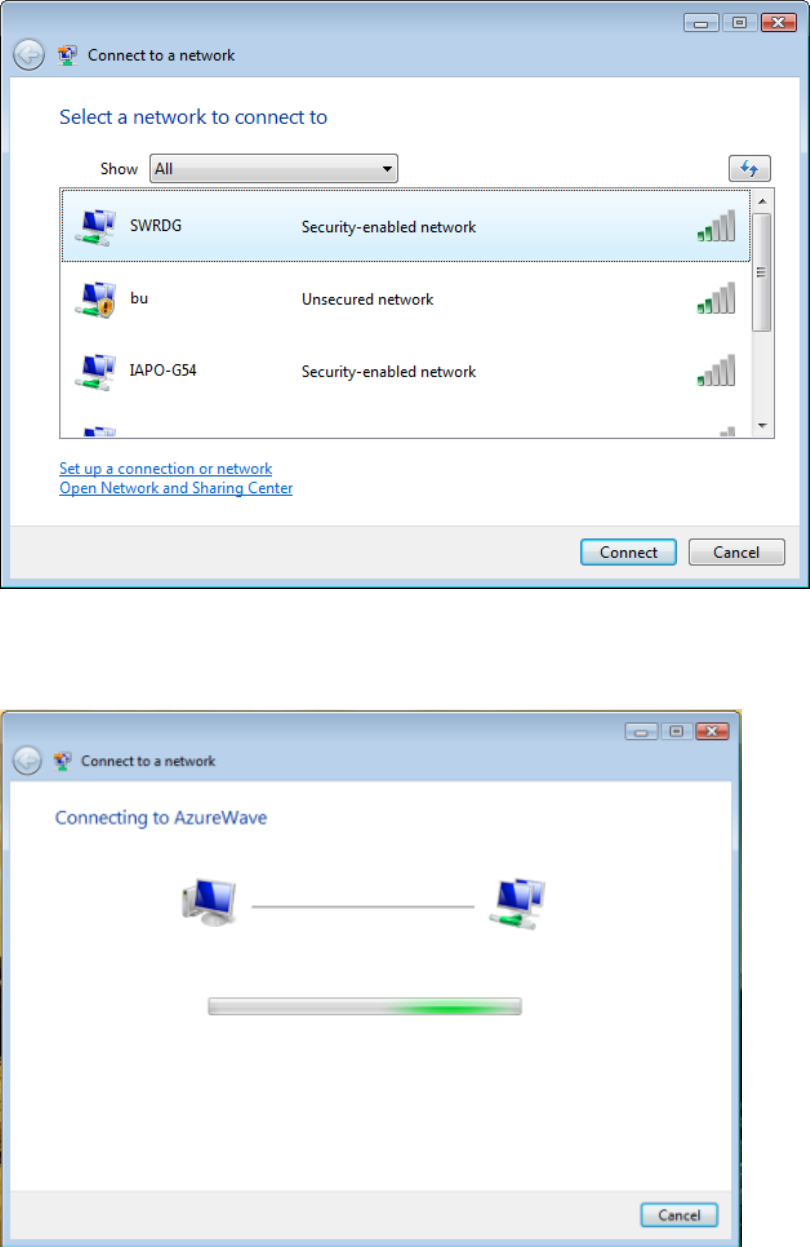
* If selected network is not secure, please choose [Connect anyway]
3. You may need to wait for few seconds when Windows connects to wireless network
4. Now the selected wireless network is connected
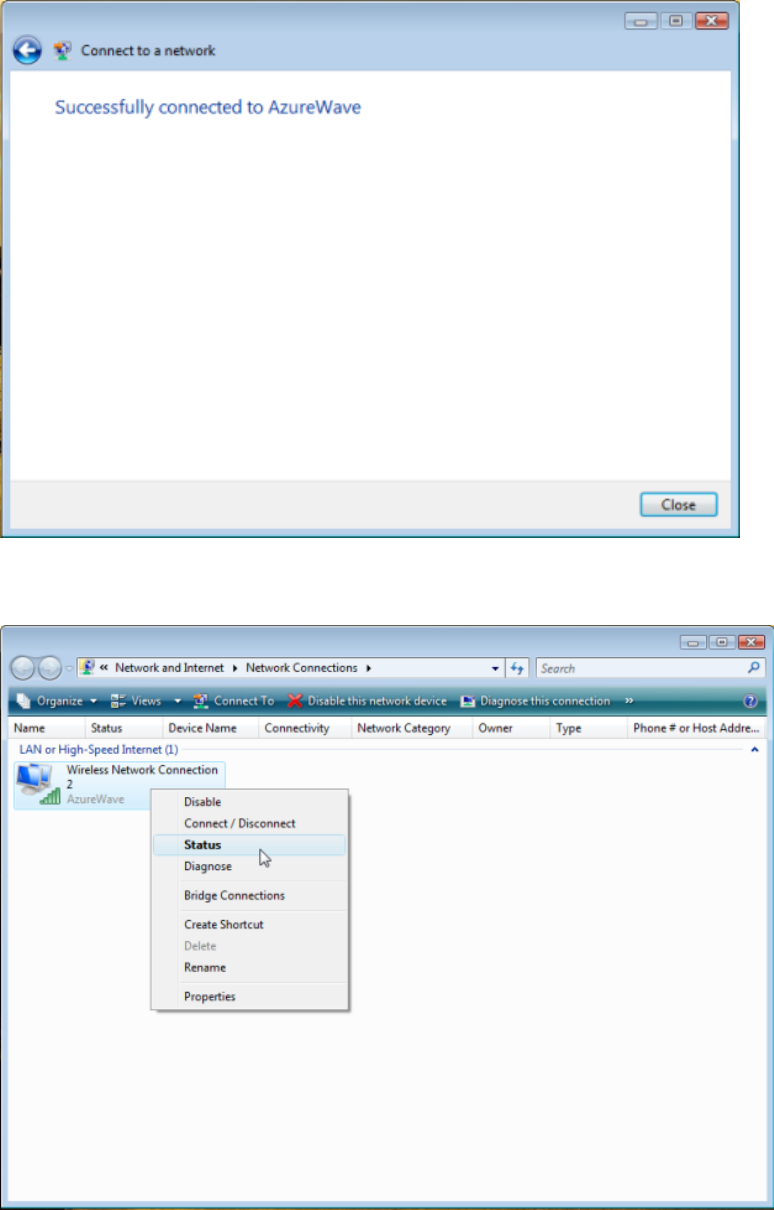
5. If you want to see the connection status, please right-click on the network you choose and select
[Status]
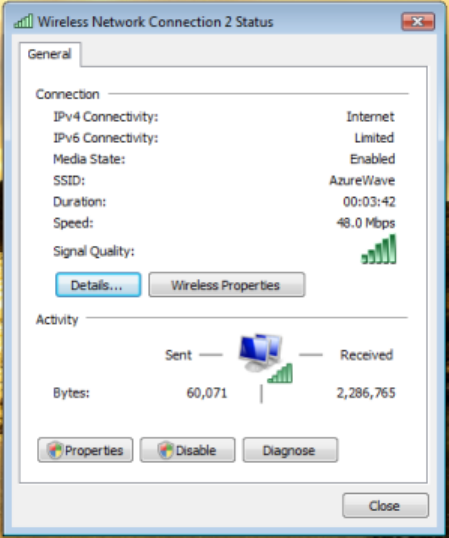
6. This is the information of network status
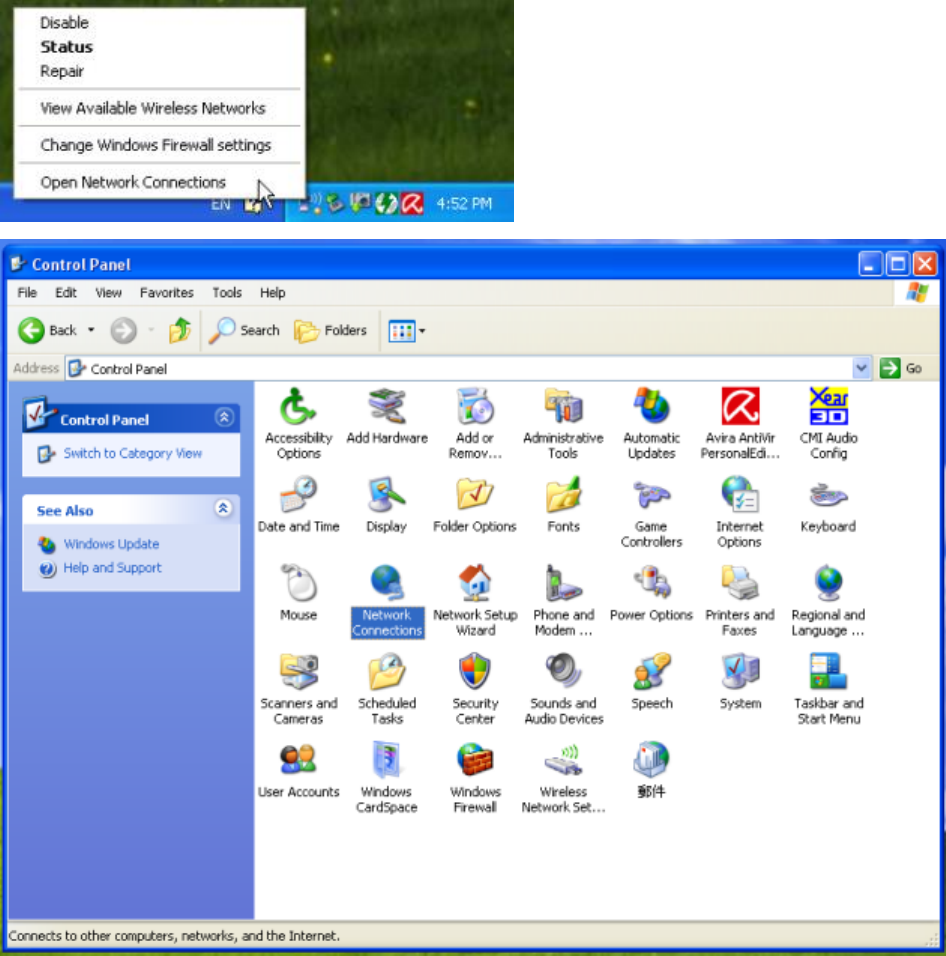
IV. Setup for Ad-hoc Mode
i. For Windows XP OS
If you want to choose Ad-hoc mode, please right-click network icon on desktop shortcut and choose
“Open Network Connections”, or go to [Control Panel] and double-click “Network Connection”
icon.
When you see the “Network Connections” screen, please follow the steps below to setup Ad-hoc
mode.
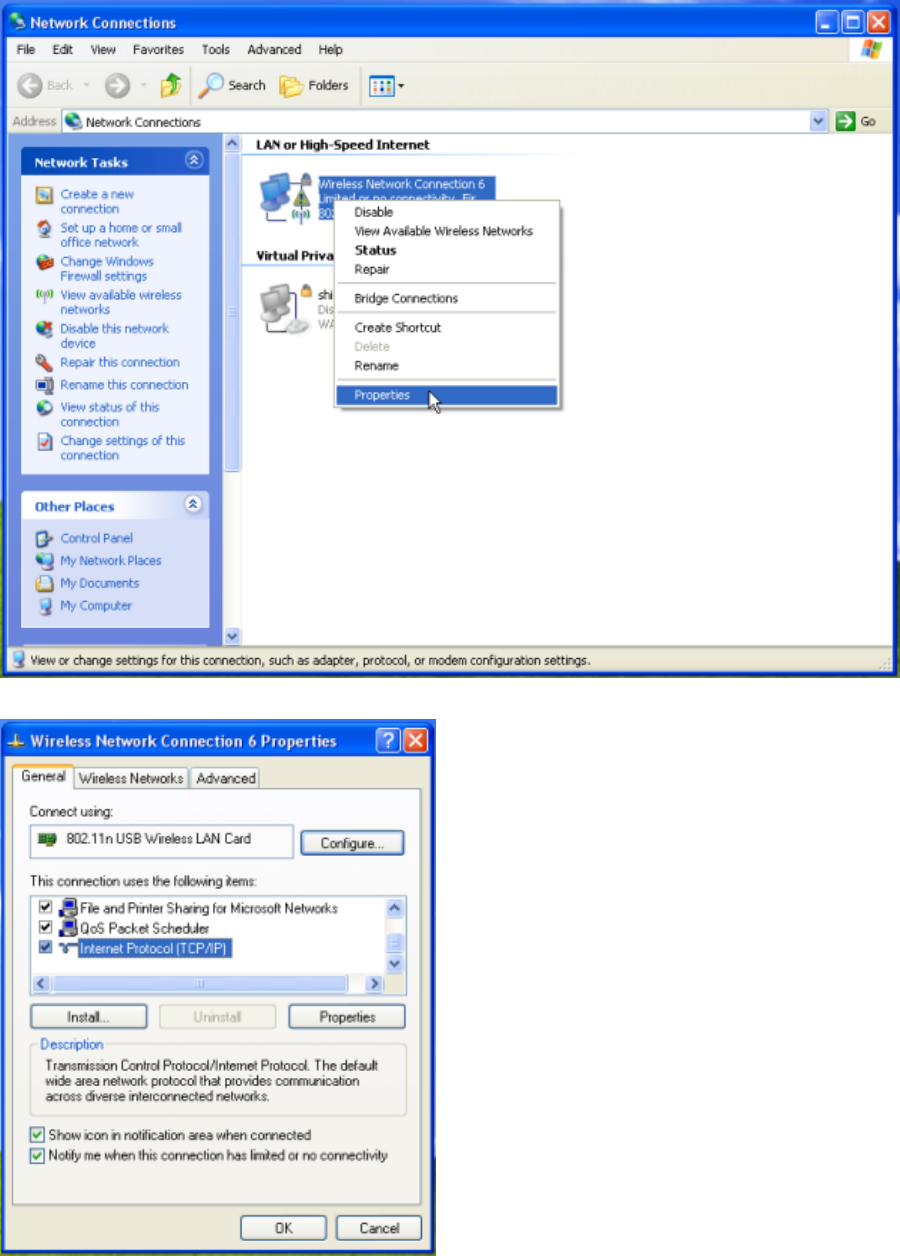
1. Double-click “Wireless Network USB Adapter” icon to enter its properties
2. Click "General” tab and double-click the “Internet Protocol (TCP/IP)” item
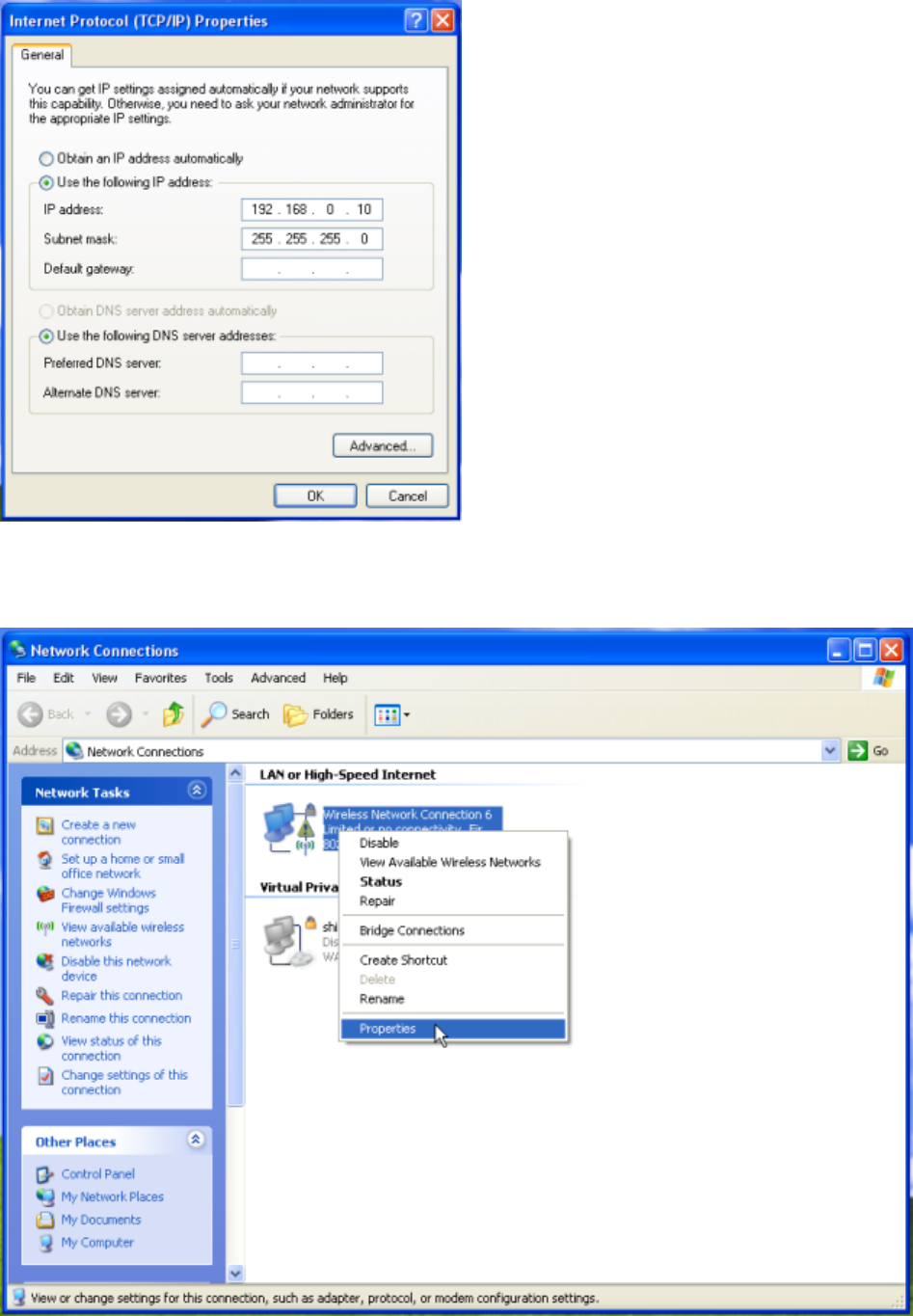
3. Choose “Use the following IP address:” and type the IP address; then click [OK]
*Note: the IP address of the other wireless card should be set with the same subnet mask
4. Right-click the “Wireless Network Connection” icon and choose “properties”
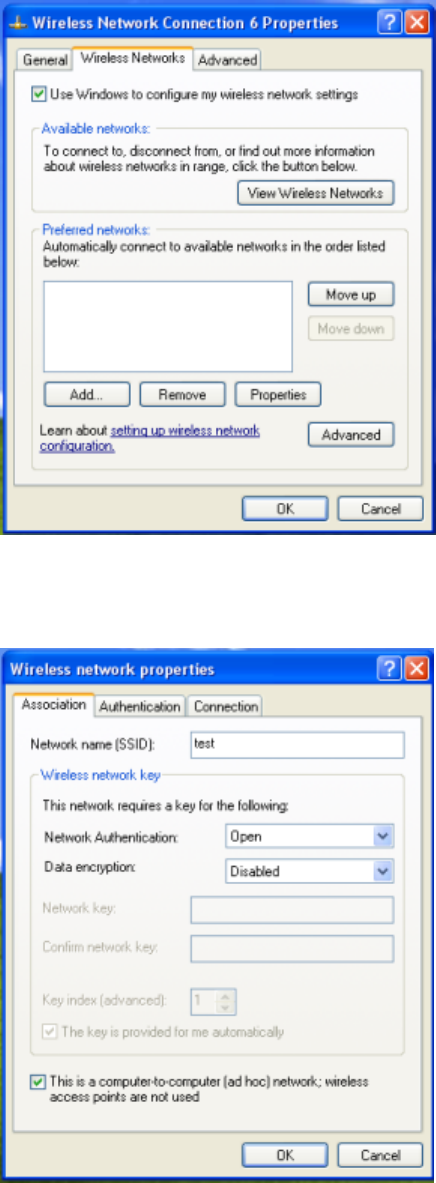
5. Select “Wireless Network” tab and choose [Add]
6. Type “Network name (SSID)” and choose “Data encryption” if you want to protect the network
security
7. When you see the dialogue showing your network is unsecured, please click [Continue Anyway]
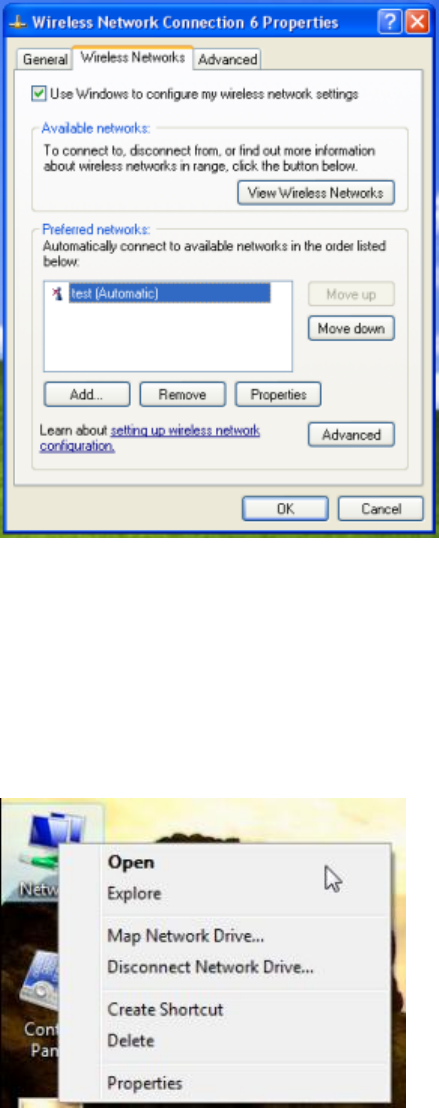
8. Now your network is in Ad-hoc mode
ii. For Windows Vista OS
Please follow the steps to setup Ad-hoc mode for Windows Vista.
1. Right-click the Network neighbor to choose “properties,” or you can right-click network icon on
desktop shortcut and choose “Network and Sharing Center”
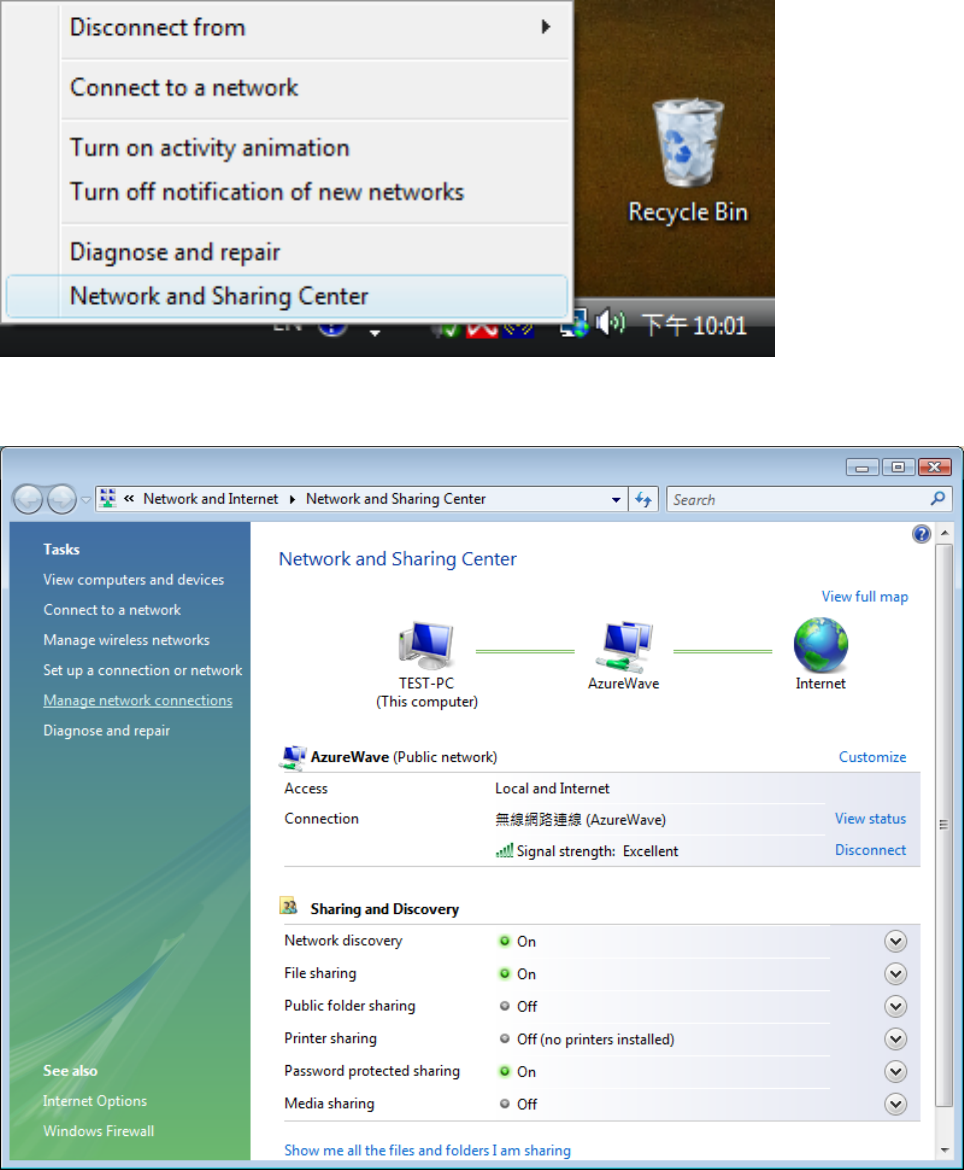
2. When you see the “Network and Sharing Center” windows, please select “Manage network
connection” bar
3. Right-click the connected network icon and choose “Properties”
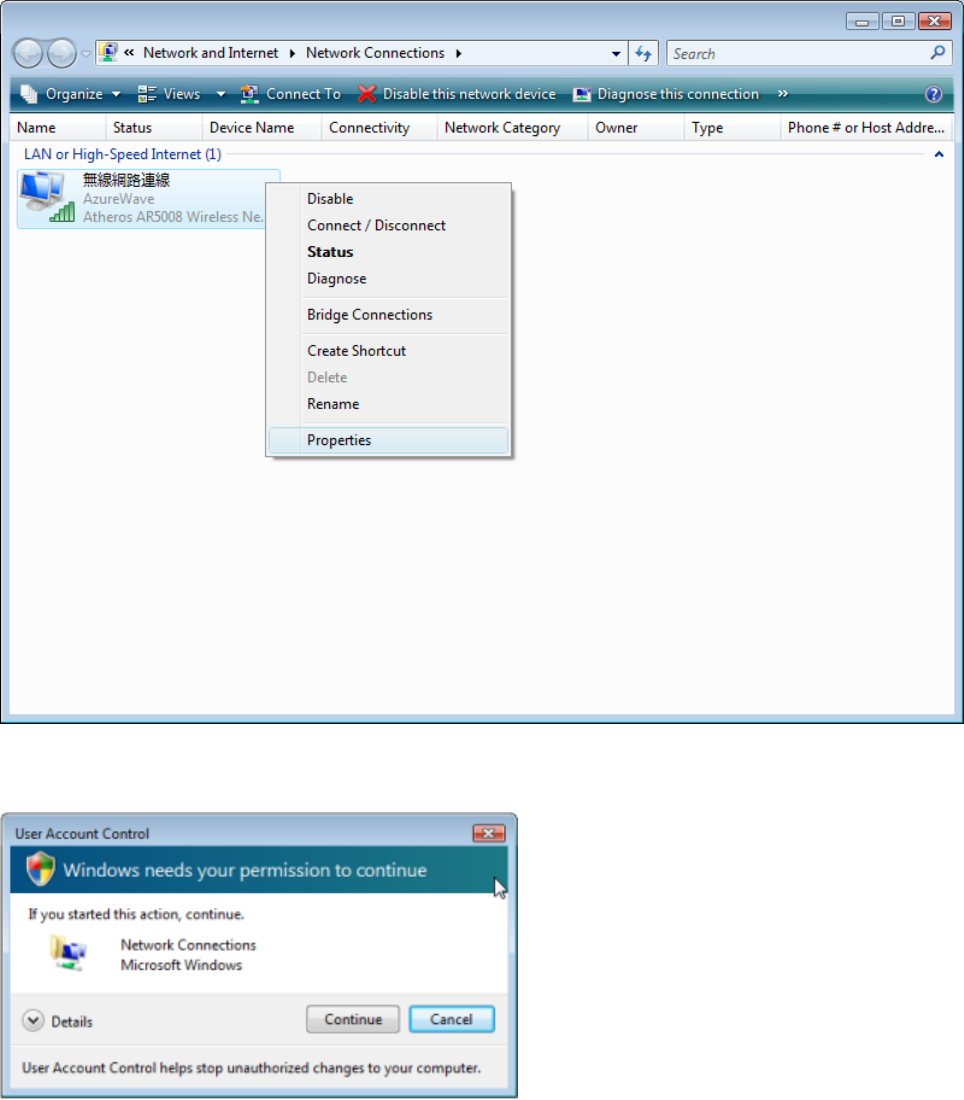
4. When you see the warning message, please click [Continue]
5. Choose “Networking” tab and double-click the “Internet Protocol Version 4 (TCP/IPv4)” item
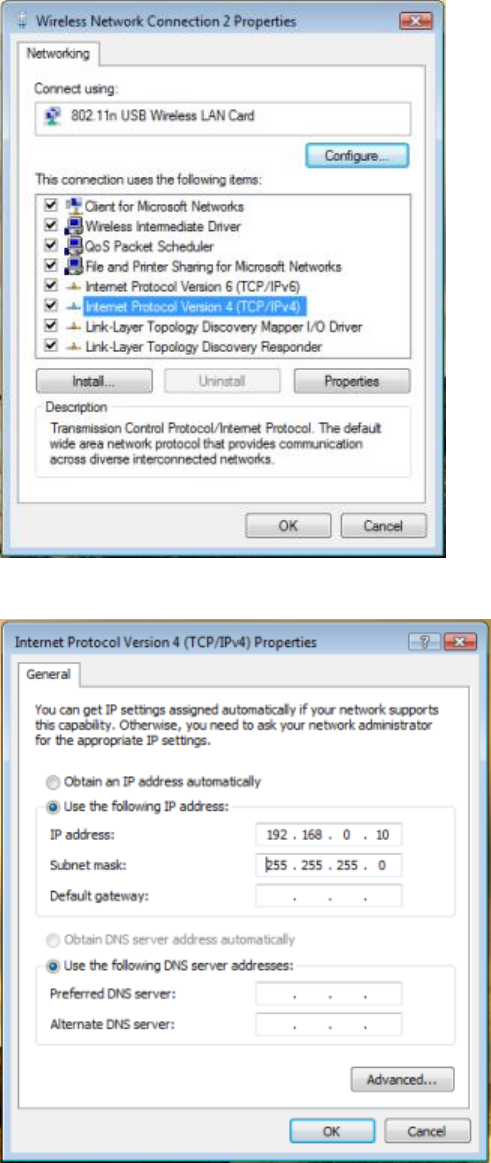
6. Choose “Use the following IP address:” and type the IP address; then click [OK]
*Note: the IP address of the other wireless card should be set with the same subnet mask
7. Choose “Manage wireless networks” bar
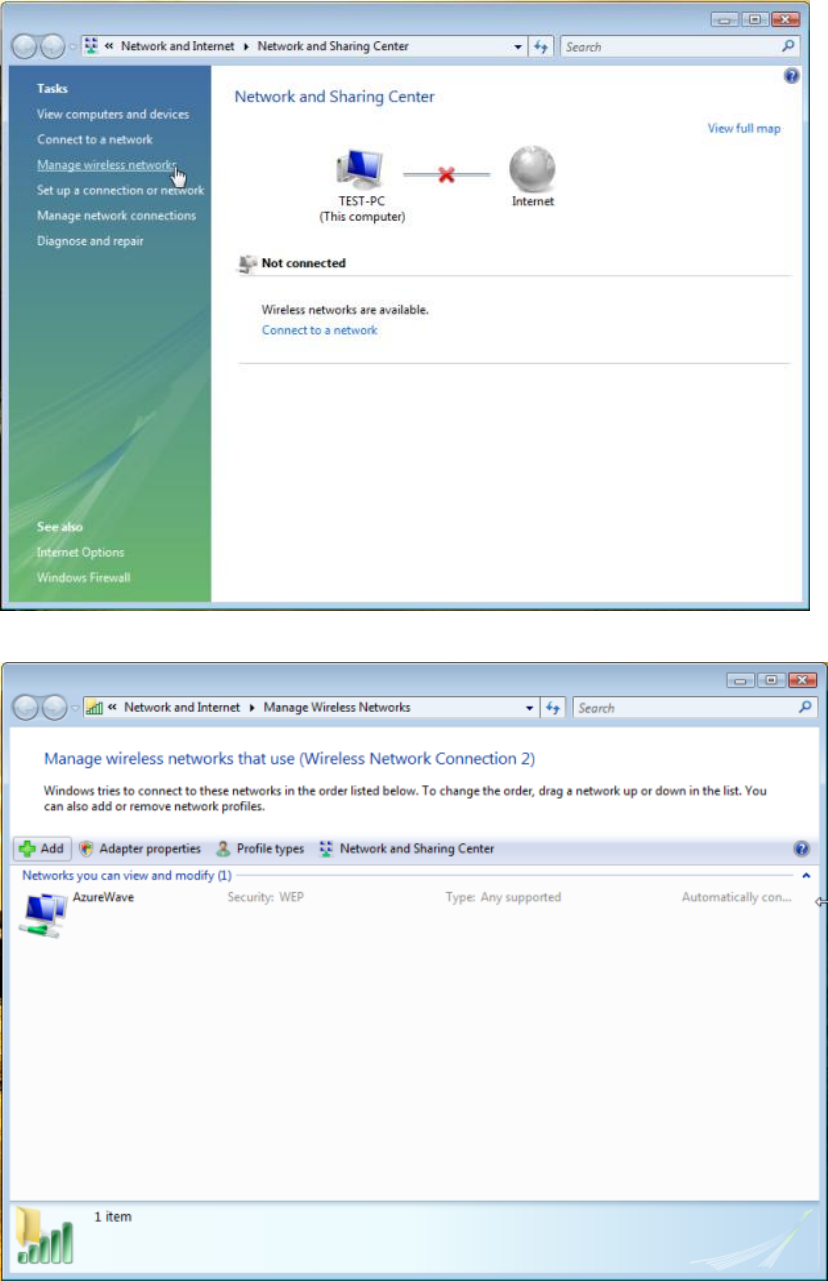
8. Select [Add]
9. Choose “Create ad-hoc network”
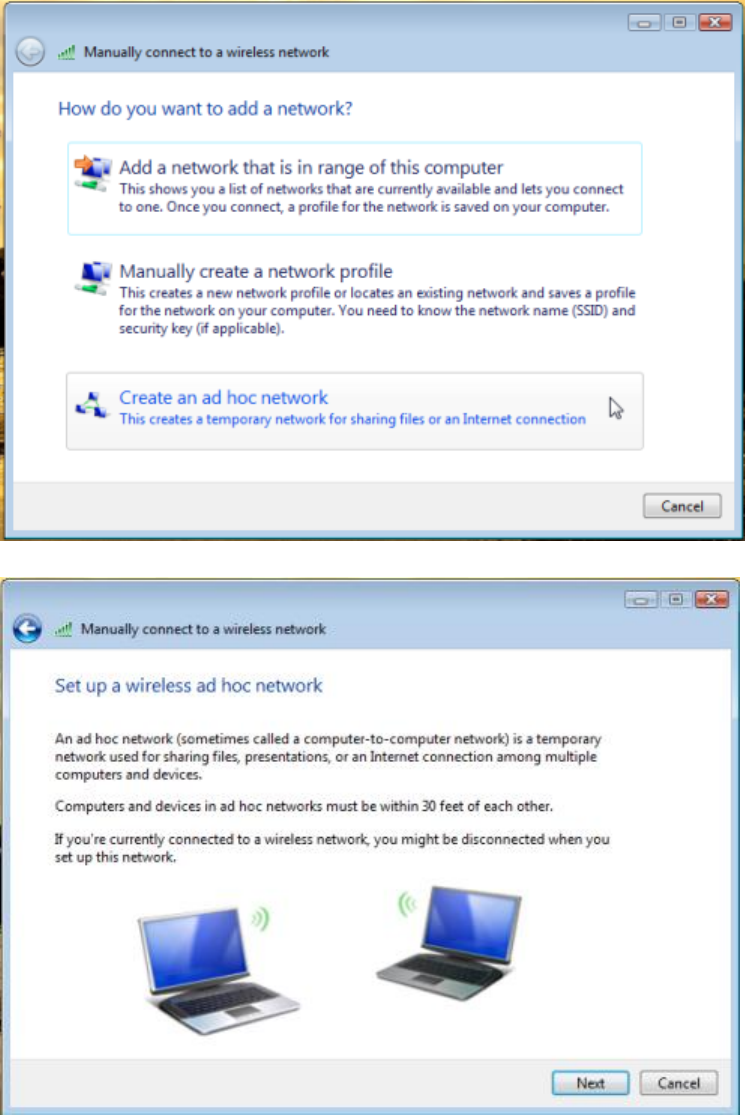
10. Please click [Next]
11. Enter “Network name” and if you want to protect the network security, please choose in
“security type”; then click [Next]
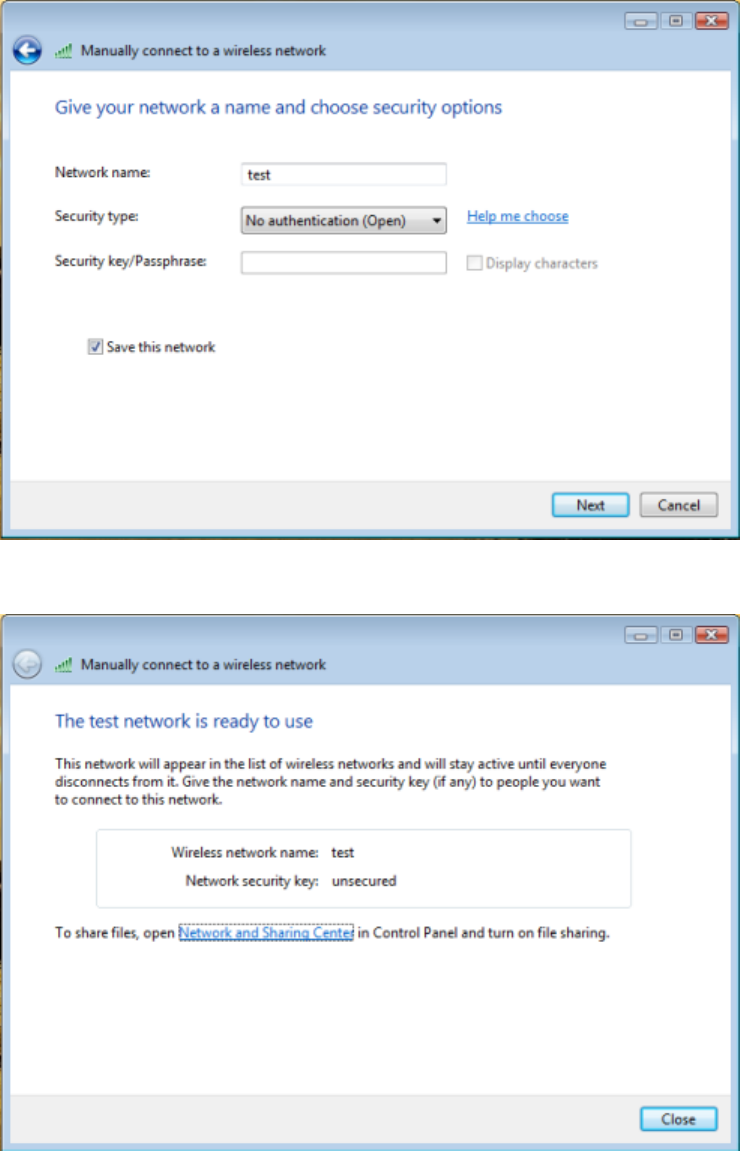
12. Now your network is in Ad-hoc mode
Federal Communication Commission Interference Statement
This device complies with Part 15 of the FCC Rules. Operation is subject to the following two
conditions: (1) This device may not cause harmful interference, and (2) this device must accept any
interference received, including interference that may cause undesired operation.
This equipment has been tested and found to comply with the limits for a Class B digital device,
pursuant to Part 15 of the FCC Rules. These limits are designed to provide reasonable protection
against harmful interference in a residential installation. This equipment generates, uses and can
radiate radio frequency energy and, if not installed and used in accordance with the instructions,
may cause harmful interference to radio communications. However, there is no guarantee that
interference will not occur in a particular installation. If this equipment does cause harmful
interference to radio or television reception, which can be determined by turning the equipment off
and on, the user is encouraged to try to correct the interference by one of the following measures:
- Reorient or relocate the receiving antenna.
- Increase the separation between the equipment and receiver.
- Connect the equipment into an outlet on a circuit different from that
to which the receiver is connected.
- Consult the dealer or an experienced radio/TV technician for help.
FCC Caution: Any changes or modifications not expressly approved by the party responsible for
compliance could void the user's authority to operate this equipment.
This transmitter must not be co-located or operating in conjunction with any other antenna or
transmitter.
Radiation Exposure Statement:
This equipment complies with FCC radiation exposure limits set forth for an uncontrolled
environment. This equipment should be installed and operated with minimum distance 20cm
between the radiator & your body.

This device is intended only for OEM integrators under the following conditions:
1) The antenna must be installed such that 20 cm is maintained between the antenna and
users, and
2) The transmitter module may not be co-located with any other transmitter or antenna.
As long as 2 conditions above are met, further transmitter test will not be required. However,
the OEM integrator is still responsible for testing their end-product for any additional
compliance requirements required with this module installed
IMPORTANT NOTE: In the event that these conditions can not be met (for example certain
laptop configurations or co-location with another transmitter), then the FCC authorization is
no longer considered valid and the FCC ID can not be used on the final product. In these
circumstances, the OEM integrator will be responsible for re-evaluating the end product
(including the transmitter) and obtaining a separate FCC authorization.
End Product Labeling
This transmitter module is authorized only for use in device where the antenna may be
installed such that 20 cm may be maintained between the antenna and users. The final end
product must be labeled in a visible area with the following: “Contains FCC ID:
TLZ-NU182H”. The grantee's FCC ID can be used only when all FCC compliance
requirements are met.
Manual Information To the End User
The OEM integrator has to be aware not to provide information to the end user regarding how
to install or remove this RF module in the user’s manual of the end product which integrates
this module.
The end user manual shall include all required regulatory information/warning as show in this
manual.